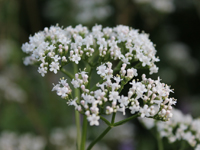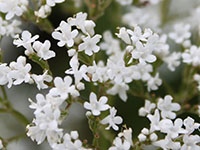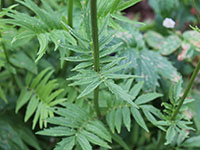![]()
Valerian is a perennial flowering plant in the honeysuckle family which is native to Europe and parts of Asia. In North America valerian has escaped gardens and has become naturalized in many area of Canada and the USA. The genus name "valeriana" comes from the medieval Latin name, possibly derived from the Latin word 'valere' meaning to be healthy in reference to the plant's medicinal uses in nervousness and hysteria. The species name "officinalis" means medicinal in reference to herbal/medicinal uses. The amino acid valine is named after this plant.
![]()
The plant yields about 1% of an essential oil from the roots which is used in perfumery to provide a 'mossy' aroma. Crude extract of valerian root is sold as a dietary supplement in the form of capsules. Plants are cultivated in Europe for producing an over-the-counter tranquilizer.
![]() Within the realm of naturopathic medicine and folklore, valerian is a well-known and frequently used medicinal herb that has a long and proven history of efficacy. It is noted especially for its effect as a tranquillizer and nervine, particularly for those people suffering from nervous overstrain. Valerian has been shown to encourage sleep, improve sleep quality and reduce blood pressure. Valerian is also used internally in the treatment of painful menstruation, cramps, hypertension, and irritable bowel syndrome. Externally, valerian is used to treat eczema, ulcers and minor injuries.
Within the realm of naturopathic medicine and folklore, valerian is a well-known and frequently used medicinal herb that has a long and proven history of efficacy. It is noted especially for its effect as a tranquillizer and nervine, particularly for those people suffering from nervous overstrain. Valerian has been shown to encourage sleep, improve sleep quality and reduce blood pressure. Valerian is also used internally in the treatment of painful menstruation, cramps, hypertension, and irritable bowel syndrome. Externally, valerian is used to treat eczema, ulcers and minor injuries.
Please note that MIROFOSS does not suggest in any way that plants should be used in place of proper medical and psychological care. This information is provided here as a reference only.
![]()
Seeds can be parched and then eaten. An essential oil from the leaves and root is used as a flavouring in ice cream, baked goods, and condiments. The leaves can also be used as a condiment. The plant is used in moderation as a herbal tea.
Please note that MIROFOSS can not take any responsibility for any adverse effects from the consumption of plant species which are found in the wild. This information is provided here as a reference only.
![]()
Valerian grows in lightly shaded woodlands, along the edges of forests, and along roadsides in cool climates. Suitable for: light (sandy), medium (loamy) and heavy (clay) soils. Suitable pH: acid, neutral and basic (alkaline) soils. It cannot grow in the shade. It prefers moist soil.
| Soil Conditions | |
| Soil Moisture | |
| Sunlight | |
| Notes: |
![]()
Valerian is a perennial which can grow 90cm to 150cm tall featuring a clump of deeply lobed basal foliage from which a tall and slender stem grows topped by highly fragrant pink, or white, flowers. Leaves of the valerian plant are odd-pinnate, each leaf having seven to ten pairs (plus terminal) of serrate, lanceolate leaflets. Leaves are aromatic when bruised. Flowers grow in branched panicles growing 5cm to 10cm wide. The flowers are frequently visited by many fly species, especially hoverflies of the genus Eristalis. It is consumed as food by the larvae of some Lepidoptera (butterfly and moth) species including the grey pug.
![]()
| Plant Height | 90cm to 150cm | 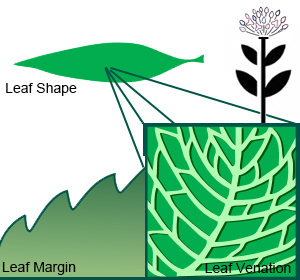 |
| Habitat | Old Fields, Roadsides, Wasteplaces | |
| Leaves | Odd-pinnate, Lanceolate | |
| Leaf Margin | Serrate | |
| Leaf Venation | Cross-venulate | |
| Stems | Straight smooth stems | |
| Flowering Season | June to August | |
| Flower Type | Rounded clusters | |
| Flower Colour | White or Pink | |
| Pollination | Insects | |
| Flower Gender | Flowers are hermaphrodite and the plants are self-fertile | |
| Fruit | Small seeds | |
| USDA Zone | 4A (-31.7°C to -34.4°C) cold weather limit |
![]()
The following health hazards should be noted when handling or choosing a location to valerian:
 |
NOTICE It is said that prolonged medicinal use of this plant can lead to addiction. |
![]()
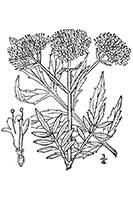 |
-Click here- or on the thumbnail image to see an artist rendering, from The United States Department of Agriculture, of valerian. (This image will open in a new browser tab) |
![]()
 |
-Click here- or on the thumbnail image to see a magnified view, from The United States Department of Agriculture, of the seeds created by the valerian plant for propagation. (This image will open in a new browser tab) |
![]()
Valerian can be referenced in certain current and historical texts under the following two names:
Valerian can be translated into the following select languages:
| Arabic | الناردين نبات | Bulgarian | валериан | Chinese (Sim) | 缬草 |
| Croatian | odoljen | Czech | kozlík lékařský | Danish | baldrian |
| Dutch | valeriaan | Esperanto | Estonian | valeriaan | |
| Finnish | virmajuuri | French | valériane | German | Baldrian |
| Greek | βαλεριάνα | Hebrew | ולריאן | Hungarian | macskagyökér |
| Italian | valeriana | Japanese | バレリアン | Korean | 발레리안 |
| Punjabi | Lithuanian | Valerijonas | Norwegian | vendelrot | |
| Persian | والرین | Polish | waleriana | Portuguese | valeriana |
| Romanian | valeriană | Russian | валериана | Slovak | valeriána lekárska |
| Spanish | valeriana | Swedish | vänderot | Tagalog | |
| Turkish | kediotu | Ukrainian | валеріани | Vietnamese |

![]()
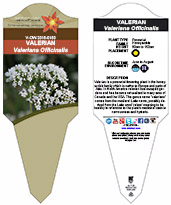 |
The MIROFOSS database offers free printable garden tags for personal and non-profit use. These tags can be used to properly identify plant samples in a garden. Click on the tags shown on the the screen or -click here- to download a full size jpeg image for a valerian identification tag; which can be printed on paper or used with a plastic laser printer. |
 |
What's this? What can I do with it? |
![]()
| Background | "BSBI List 2007". Botanical Society of Britain and Ireland. |
| Background | Dickinson, R.; Royer, F.; (2014) Plants of Southern Ontario. ISBN 978-1-55105-906-8 |
| Background | "Teasel." The Oxford English Dictionary. 2nd ed. 1989. |
| Biology | Shaw, P. J. A.; Shackleton, K. (2011). Joly, Simon, ed. "Carnivory in the teasel Dipsacus fullonum — the effect of experimental feeding on growth and seed set" |
| Biology | Dickinson, T.; Metsger, D.; Bull, J.; & Dickinson, R. (2004) ROM Field Guide to Wildflowers of Ontario, Royal Ontario Museum, Toronto:McClelland and Stewart Ltd. |
| Environment | National Audubon Society. Field Guide To Wildflowers (Eastern Region): Alfred A. Knopf. ISBN 0-375-40232-2 |
| Physical Identification | National Audubon Society. Field Guide To Wildflowers (Eastern Region): Alfred A. Knopf. ISBN 0-375-40232-2 |
| March 02, 2018 | The last time this page was updated |
| ©2025 MIROFOSS™ Foundation | |
 |
|

